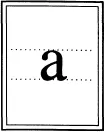![]()
LOWER-CASE A
IPA USAGE
Cardinal Vowel No. 4: front unrounded. Described in Principles (p. 8) as the vowel sound of Northern English back or Parisian French patte. In the speech of Chicago, Illinois (and in various other varieties of American English), the word pop is pronounced as IPA [pap]. In the speech typical of Boston, Massachusetts, the pronunciation of the word park is approximately [pa:k].
AMERICAN USAGE
Same as IPA for many writers (see, e.g., Bloch and Trager 1942 (p. 22); Pike 1947 (p. 5); and Smalley 1963 (p. 263)); but many American linguists (see, e.g., Gleason 1955 (p. 8) and Chomsky and Halle 1968) do not distinguish [a] from [ɑ], either one being used for any low unrounded vowel distinct from [æ], the choice depending on typographical considerations. Thus in some American writings, [a] is used as a low back unrounded vowel, as in pap, which is IPA [pap] in many American dialects, but may be transcribed [pap]. In Crothers 1978 (p. 137) it is used for a low central vowel, IPA [ɐ].
OTHER USES
Universally used by Indologists for the short mid (or lower-mid) central unrounded vowel of Indic languages such as Hindi. Thus, for example, Fairbanks and Misra (1966) write
kab
for the Hindi word meaning ‘when’, IPA [k
əb] or [k
ɐb].
COMMENTS
While many American linguists refer to [æ] as a low front vowel, the IPA and most careful American authorities are in agreement that [æ] represents a vowel slightly higher than fully low (between Cardinal 3 and Cardinal 4), while IPA [a] is defined as the most open front vowel possible (Cardinal 4).
The IPA’s effort to establish
a
and
ɑ as separate symbols “has not met with the success originally hoped for” (
Principles, 19). The fluent reader of roman letters is too accustomed to ignoring the difference between them when switching between fonts or between handwriting and printing or typing. No orthography has adopted the two symbols as contrasting letters, though they are used as contrasting symbols in Isaac Pitman’s 1845 phonotypic alphabet (cf. Pitman and St. John 1969 (p. 82) and some dictionary pronunciation guides.
SOURCE
Roman alphabet, lower case (as usually found in typesetters’ fonts and typewriter elements).
Overdot A
Not in general use, but following the recommendations of Boas et al. (1916, 10) for the use of an overdot as a diacritic for central vowels, used by Bloch and Trager (1942, 22) for a low unrounded central vowel, approximately IPA [
ɐ] It is used for a low central
rounded vowel in Crothers 1978 (p. 137), where “[a]” is used for Bloch and Trager’s [
ȧ].
Umlaut A
IPA Usage: According to Principles (p. 16), an open central unrounded vowel, though the current interpretation of the umlaut diacritic makes it an open centralized front unrounded vowel. American Usage: According to the widely followed recommendation of Boas et al. (1916, 9) on the use of the umlaut with vowel symbols, if [a] is a low back vowel, [ä] would be a low front unrounded vowel, i.e., IPA [a] (or perhaps [æ]). Used in this sense in Crothers 1978 (p. 137). Where [a] is used for a low front unrounded vowel (e.g., Bloch and Trager 1942 (p. 22) [ä] is a low back unrounded vowel. The symbol is not i...










